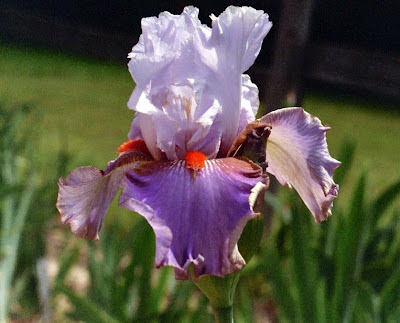By Andi Rivarola
Here's yet another announcement of an AIS medal winner. Hope you like seeing their pictures and descriptions. This is the way I have always dreamed of seeing them, slowly in order to absorb their magnificence one by one.
This time the 2012 Clarence G. White Medal: 'Noble Warrior,' hybridized by Rick Tasco of California.
A complete list of winners in other categories can be found on the AIS website.
Here's a full description of this beautiful iris:
'Noble Warrior' (Richard Tasco, R. 2005) Sdlg. 01-AB-14-10. AB (OGB), 33" (84 cm), EM, Standards are creamy ivory, light yellow midrib and veins that lighten toward edge; style arms golden yellow; Falls are slightly recurved, golden yellow, burgundy red (RHS 187B) veining, darker on hafts and around signal, lightening toward bottom, large round burgundy red signal; beards wide golden yellow in throat, narrow bronzed yellow in middle and end, tipped tiny insignificant burgundy overall; slight musky fragrance. English Eyes X Bagdad's Folly. Superstition 2006. AIS Awards: HM 2008, AM 2010.
 |
| Photo by Rick Tasco
I contacted Rick Tasco because I did not have a picture of 'Noble Warrior' to share with all of you, and since I had his attention I also asked him why he decided to work on Arilbred irises and what were his goals.
Here's what he wrote back:
"I started to hybridize arilbreds because I lived in locations where they grew well, the Valley of the Sun in AZ, and the lower Sierra foothills in Central California. There aren't many arilbred hybridizers out there and not enough arilbreds are available, so I saw a field that needed more varieties. I enjoy their unusual patterns and characteristics.
One of my goals in hybridizing arilbreds was to get veins and a large signal on the falls. 'Noble Warrior' is a step towards my goal. I'm still working for more and bolder veins and a larger signal. I'm never satisfied."
(AR) Arils
The aril irises include some of the most amazing plants in the genus Iris, from the largest flower (over a foot in length) to tiny dwarfs (the whole plant only a couple of inches high). Arils can also be the most challenging plants to grow, requiring exacting conditions, but the glorious exotic flowers and the pride of achievement compensate for the effort. Arils have been crossed with their easier cousins the true bearded irises to create arilbreds, a separate horticultural class that brings easier culture but retains some of the exotic traits of the pure arils. Arils tend to come from areas of restricted rainfall. They are often referred to as desert iris. But depending on the species these "deserts" can range from high Himalayan plateaus to coastal Mediterranean climates. Most require a dry summer dormancy.
Aril iris are so named because of the fleshy collar on one end of the seed that is believed to be food for ants. When the ants carry it off they plant the seed. Aril Iris have distinctive beards, different from the better known bearded Irises. In some cases the beard may be a broad patch of short hairs that appear like velvet. Many of the Oncocyclus types have large black spots below the beard that rivet the eye. The color palette of the flowers has often been compared to Oriental rugs and may have been an inspiration to the artisans since they both originate in the same parts of the world such as Turkey, Iran, Afghanistan, etc.
The Clarence G. White Medal
The highest award given by the American Iris Society strictly to Aril and Arilbred Irises with 1/2 or more aril content
History from Clarence Mahan:
This medal is restricted to irises of one-half or more aril content that clearly exhibit at least two readily recognizable aril flower characteristics as defined and approved by the Aril Society International. It is named in honor of Clarence G. White (1869-1957).
Clarence G. White was born in Cleveland, Ohio. After attending Harvard University, he worked for the White Sewing Machine Company, which had been founded by his father. Later he operated his family's plantation in Florida. His experiments with potato growing in Florida have been credited with being the basis for establishing the potato business in that state. He moved to Hawaii in 1905, and there he owned and operated a large pineapple plantation. He was involved in many philanthropies and civic activities. He moved his family to Redlands, California in 1919, and he began raising flowers and extending his works of civic philanthropy. It was at this time that White developed an interest in and irises.
More on the Clarence G. White Medal, such as its history and past medal winners, can be found on the Iris Wiki.
For more information on AIS Awards, please visit our website.
|



















